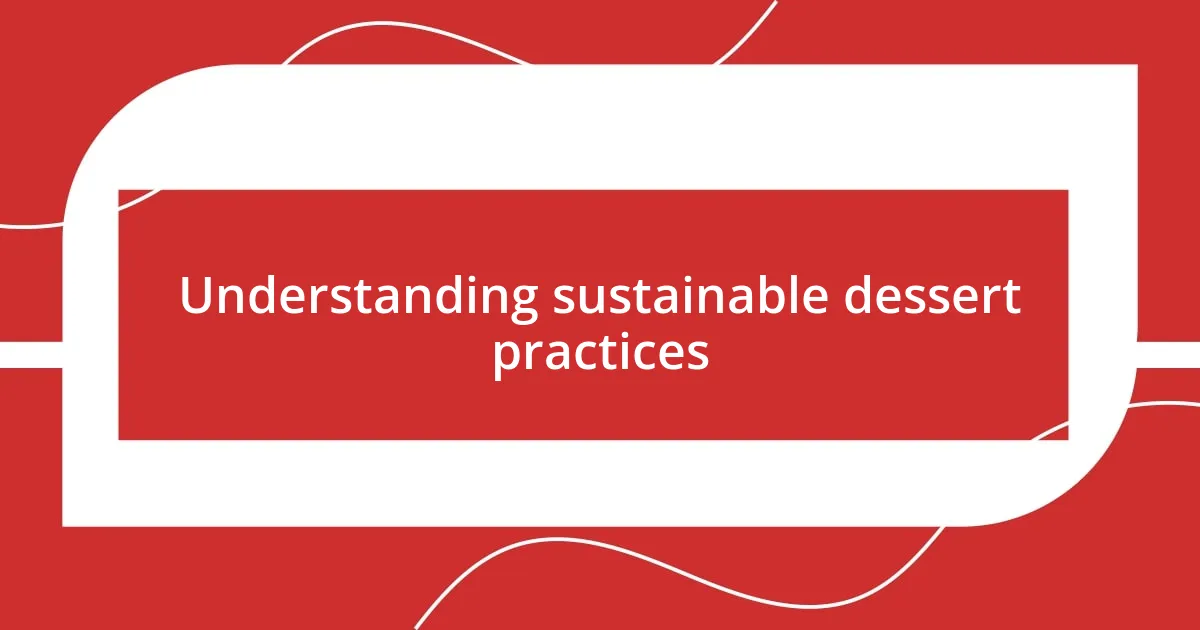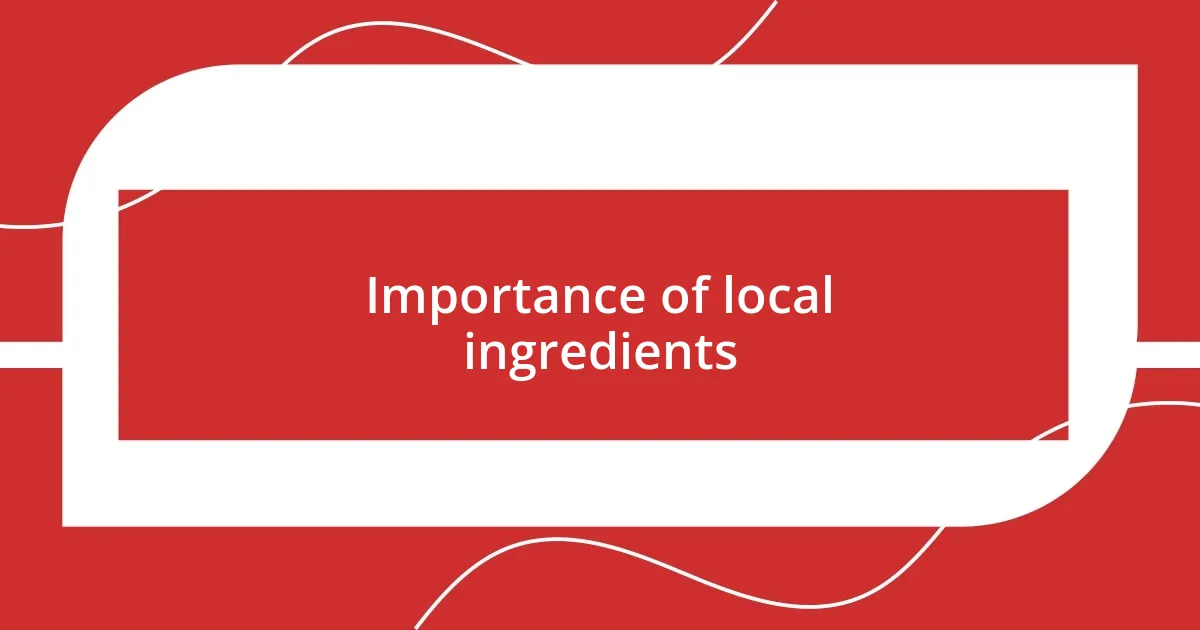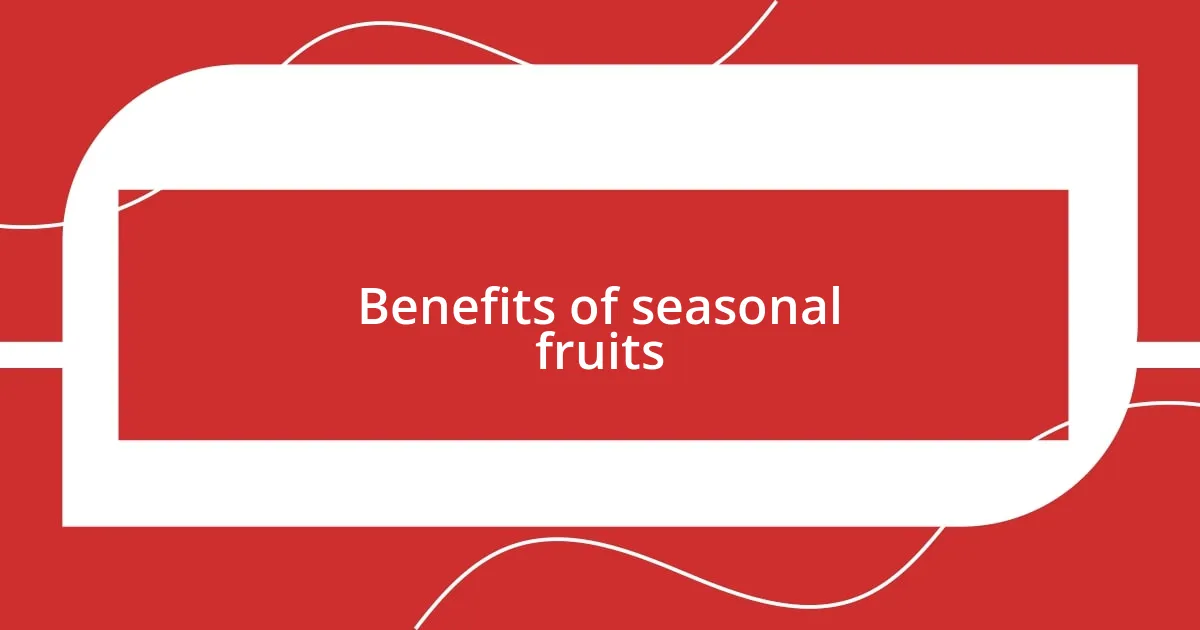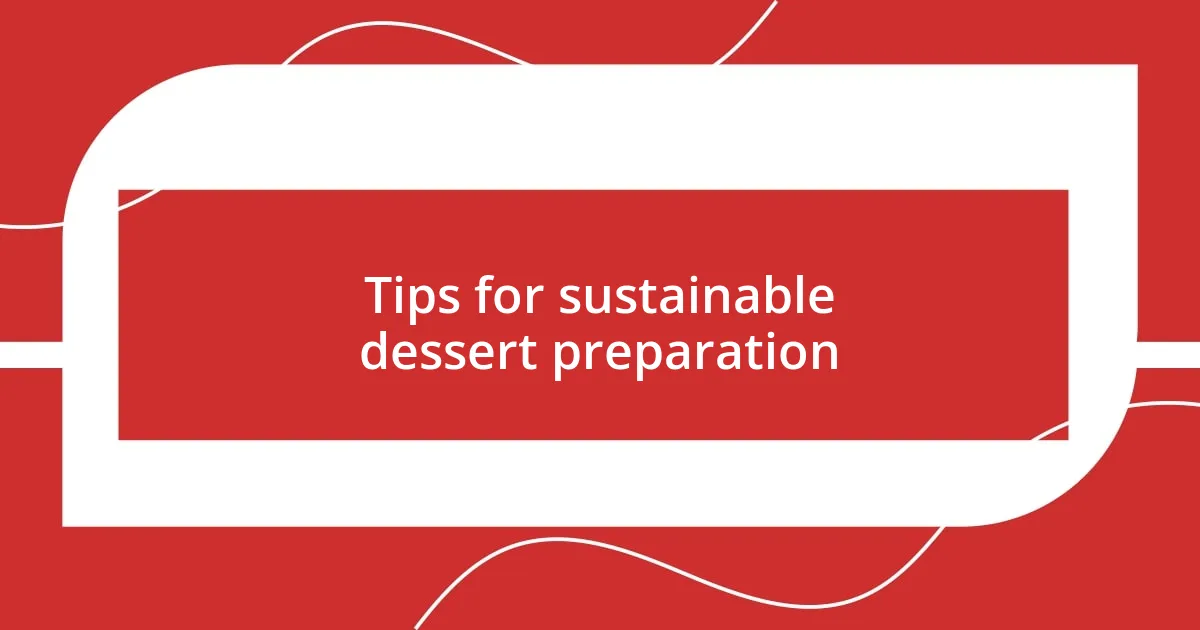Key takeaways:
- Sourcing local ingredients enhances the flavor of desserts, supports local economies, and reduces carbon footprints.
- Incorporating seasonal fruits improves taste, nutritional value, and encourages biodiversity in agriculture.
- Utilizing natural sweeteners and plant-based alternatives can make desserts healthier and equally satisfying.
- Embracing eco-friendly packaging and minimizing food waste are essential steps in sustainable dessert practices.

Understanding sustainable dessert practices
Sustainable dessert practices revolve around sourcing ingredients that are not only delicious but also environmentally friendly. I remember the first time I visited a local farm where they showcased how seasonal fruits could transform a simple dessert. It struck me how using fresh, local produce not only supports local economies but also reduces carbon footprints associated with transport.
When I think about sustainability, I can’t help but consider the impact of food waste. Did you know that around one-third of all food produced globally goes to waste? I’ve started experimenting with leftover ingredients, like using overripe bananas for a rich, moist cake or crafting compotes from fruit that’s past its prime. It’s amazing how creativity in the kitchen can lead to not just reduced waste, but delightful new flavor combinations.
Emphasizing plant-based options is another essential facet of sustainable desserts. For example, I recently made a vegan chocolate mousse using avocados, and the result was surprisingly rich and creamy. Have you tried integrating more plant-based recipes into your dessert repertoire? It’s a fulfilling way to indulge your sweet tooth while being kind to the planet.

Importance of local ingredients
Using local ingredients is vital in crafting sustainable desserts. When I visit farmer’s markets, I love discovering unique flavors that aren’t available in typical grocery stores. The joy of picking ripe berries straight from the farm not only heightens a dish’s freshness but also fosters a connection to the land and its seasons. It’s this kind of relationship that makes me feel more in tune with the foods I prepare.
Another aspect that stands out to me is the positive impact on our local communities. Sourcing ingredients from nearby farmers not only supports their livelihood but also creates a sense of camaraderie among local food producers. I recall a time when I collaborated with a local chocolatier for a dessert event. The experience was incredibly rewarding, as I learned about the passion that goes into crafting high-quality chocolate just a few miles from my kitchen.
Let’s not underestimate the environmental benefits either. The shorter travel distances for local produce significantly reduce carbon emissions from transportation. I often find myself contemplating how the flavor of a dessert can be elevated when the ingredients are fresh and seasonal. You know that moment when the scent of basil wafts through the air while baking a pie? It’s a beautiful reminder that local ingredients inject not only flavor but also a sustainable philosophy into our desserts.
| Aspect | Local Ingredients |
|---|---|
| Freshness | Significantly enhances taste and quality |
| Community Support | Strengthens local economy and relationships |
| Environmental Impact | Reduces carbon footprint and promotes sustainability |

Benefits of seasonal fruits
One of the most delightful benefits of using seasonal fruits is their unparalleled flavor and sweetness. I remember enjoying the first strawberries of the summer; they were bursting with flavor in a way those out-of-season ones simply cannot match. It’s like nature’s way of reminding us that when fruits are picked at their peak ripeness, they not only elevate our desserts but also bring a sense of joy and satisfaction to our taste buds.
Here’s why I cherish seasonal fruits in my desserts:
- Taste: They are often more flavorful, which means simpler desserts can taste extraordinary.
- Nutritional Value: Seasonal fruits are usually fresher and packed with nutrients, contributing to better health.
- Support for Biodiversity: By opting for a variety of seasonal fruits, we support local agriculture and encourage biodiversity in farming.
- Cost-effective: Seasonal fruits tend to be more affordable due to their abundance and local availability, making them a smart choice for my wallet.
When I bake a peach cobbler in late summer, I can’t help but feel an emotional connection to the fruit—each bite takes me back to warm, sun-drenched afternoons spent picking peaches at a local orchard. Those memories, combined with the incredible taste of ripe, juicy peaches, remind me that seasonal fruits are not just ingredients; they are the essence of the seasons and a celebration of our natural world.

Reducing sugar in desserts
One of the most effective ways I’ve found to reduce sugar in desserts is by harnessing the natural sweetness of fruits. For instance, when I whip up a banana bread, I often rely on overripe bananas to achieve that rich, sweet flavor without needing to add extra sugar. Have you ever tasted a warm slice fresh from the oven, knowing that the sweetness came solely from nature? It’s a delightful discovery that transforms a recipe into a wholesome treat.
I also love experimenting with spices to enhance flavor without relying on sugar. A dash of cinnamon or a hint of vanilla can elevate a dessert remarkably. Recently, while preparing a spiced carrot cake, I was amazed at how the combination of nutmeg and ginger made the cake taste indulgent, even with significantly less sugar. It’s fascinating to realize how our taste experience can be enriched using these simple ingredients.
Another trick I’ve adopted is substituting refined sugar with natural sweeteners like honey or maple syrup, which provide a richer flavor profile. On chilly evenings, I often make a simple yogurt parfait using plain yogurt, seasonal fruits, and a drizzle of honey. I find that not only does this combination satisfy my sweet tooth, but it’s also a nourishing choice that leaves me feeling energized instead of sluggish. How do you feel about using alternatives to traditional sugar in your desserts? It can truly open a world of flavors while promoting a healthier lifestyle.

Using plant-based alternatives
Using plant-based alternatives in desserts has truly transformed the way I approach baking. Recently, I swapped out traditional dairy with coconut cream in my favorite chocolate mousse recipe. The result? A rich, velvety texture that not only satisfied my sweet cravings but also made me feel good about my choices. Have you ever experimented with non-dairy options? It’s exciting to discover how these ingredients can bring new life to familiar recipes.
I’ve also had success using aquafaba, the liquid from canned chickpeas, as an egg substitute in my brownies. It’s a bit unconventional, but the first time I whipped it up into fluffy peaks, I felt like a mad scientist in the kitchen! The brownies turned out incredibly fudgy and moist, and I couldn’t help but share my discovery with friends. They were shocked to learn their indulgence was completely egg-free. Doesn’t it feel rewarding to surprise others with a dessert that’s both delicious and plant-based?
For those who may think that plant-based desserts lack the comfort of traditional recipes, I invite you to try making a vegan cheese cake with cashews soaked in water. Blending them into a creamy mixture with a splash of maple syrup and some fresh lemon juice results in a dessert so delightful that you’ll forget it’s dairy-free. I remember serving this at a gathering, watching as my friends devoured it. The look of pure bliss on their faces made me realize that enjoying dessert sustainably can be just as satisfying. What’s holding you back from embracing these alternatives in your own baking adventures?

Eco-friendly packaging solutions
Using eco-friendly packaging solutions has been a game changer in my journey toward sustainable dessert practices. I’ve discovered that opting for biodegradable materials like plant-based films or compostable boxes adds an extra layer of consciousness to my dessert creations. Recently, I took a leap by wrapping homemade cookies in newspaper instead of plastic wrap for a local market, and the positive feedback was heartwarming! Who would have thought that a simple shift could resonate so much with customers wanting to make eco-friendly choices?
I’ve also loved the idea of using reusable containers for my treats whenever possible. For example, I often encourage friends to bring their own jars for my homemade jams or desserts at gatherings, turning the act of dessert-sharing into an eco-friendly event. It’s fulfilling to see their enthusiasm! Have you ever considered how little changes in packaging can make a significant impact on waste reduction? It’s empowering to be part of a larger movement toward sustainability, one dessert at a time.
One of my favorite experiences involved crafting DIY packaging from recycled materials. I transformed old fabric scraps into adorable dessert bags for a bake sale, embellished with colorful twine. Not only did these bags look charming, but they also carried a story, connecting our community’s commitment to sustainability. It’s eye-opening to realize that the way we package our creations can be just as delightful as the desserts themselves. What creative solutions can you envision for reducing your packaging footprint?

Tips for sustainable dessert preparation
One of the simplest yet impactful tips for sustainable dessert preparation is to shop locally for ingredients. I remember the first time I visited a local farmer’s market to pick up fresh strawberries for a tart. Not only were they more flavorful than the ones from the supermarket, but knowing I was supporting local farmers added an extra layer of joy to my baking process. Have you ever tasted a dessert that used seasonal fruits? It’s a game-changer!
In addition to choosing local, I’ve found that experimenting with whole ingredients can elevate my desserts while keeping them sustainable. For instance, I once made a chocolate bark using only dark chocolate, nuts, and dried fruits. Each bite was packed with nutrition and flavor, and I felt accomplished knowing I wasn’t overloading it with refined sugar or artificial additives. Isn’t it wonderful to create something delicious that also nourishes the body?
Lastly, embracing the concept of waste reduction could be a delightful challenge in your dessert-making journey. I often set aside leftover scraps from fruit prep—like apple cores or citrus peels—to make homemade fruit syrups or compotes. The process not only minimizes waste but also sparks creativity in the kitchen. Have you ever repurposed your kitchen scraps? It opens up a whole new world of flavors and ideas, turning what might have been thrown away into something scrumptious.















